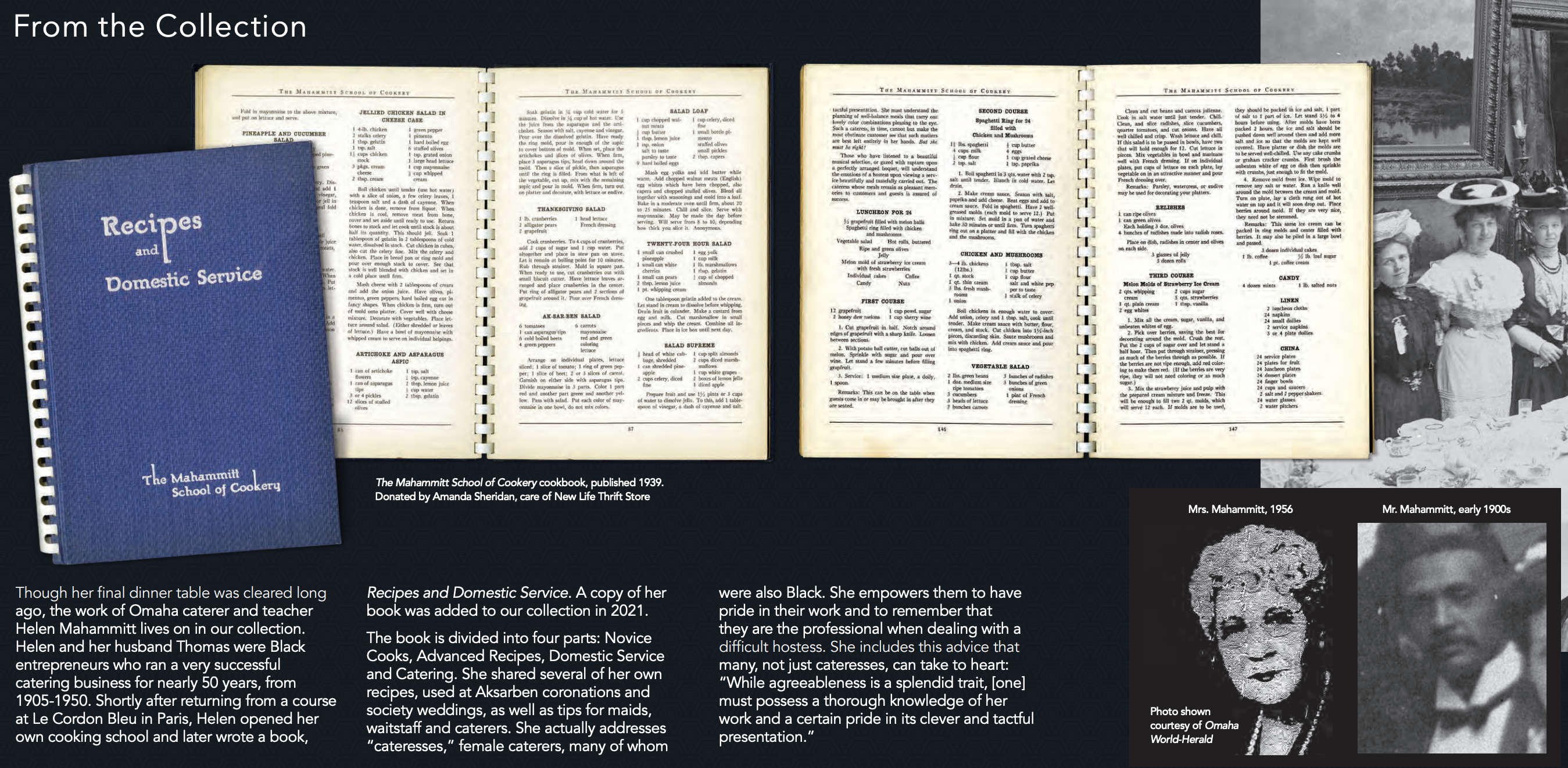African American women have led North Omaha culture, politics and business for more than 150 years. Sometimes they have stood out front, lifting up the community and building bridges through direct leadership. Other times they have led from behind by supporting their families, driving the economy and living successfully. Following are the life and times of a woman who led from behind and in front throughout her life. This is a biography of Helen Mahammit, a leading African American caterer, chef and teacher in Omaha for 45 years.
“One of Omaha’s foremost caterers.”
—”Leading city caterer dies,” Omaha World-Herald Omaha World-Herald, November 27, 1956
Sarah Helen B. Toliver Mahammitt (1869-1956) was a leading businesswoman in North Omaha. She was a chef, teacher and author, and ran a catering business from 1905 to 1950. Mrs. Mahammitt studied at Le Cordon Bleu in Paris 1927, and is credited with bringing formal, European style cooking to African-American women for use in their homes and businesses in Omaha.

Helen’s husband was Thomas P. Mahammitt (1862-1950), a popular figure in North Omaha throughout his life. Helen and Thomas were married in 1904, and lived at 2703 Binney Street. It was his second marriage, and they had no children together. The couple were dedicated members of St. Philips Episcopal Church, a segregated congregation in the Near North Side neighborhood.
For a decade after she began her career in 1904, Mrs. Mahammitt was the caterer of the Ak-Sar-Ben coronations at the original Ak-Sar-Ben Den on North 20th Street (Florence Boulevard). She served “some sort of repast” to knights and ladies after the ceremony.
Mrs. Mahammitt attended Miss Farmer’s Catering School in Boston in 1910.
In the 1930s, Mrs. Mahammitt also coordinated the semi-annual Chicken Dinners at the segregated St. Benedict’s Parish in the Near North Side neighborhood. She also conducted cooking classes for the parish in the daytime and at night, and they were always packed.
When she worked with her husband, Mrs. Mahammitt always cooked and managed the kitchen while her husband managed the front end staff and appearance. Mrs. Mahammitt also managed buying and the business, and fixed the sophisticated salads and fancy desserts. In 1935, she said her most popular dessert was a vanilla ice cream strawberry shortcake mould.
Mahammitt School of Cookery
“I have always thought that if I knew anything about cooking that others didn’t that I would like to leave it behind when I go.”
—Helen Mahammitt, as quoted in “Cateress who studied art in Paris plans to open cooking school here” from the Omaha World-Herald on December 1, 1927.

In 1926, Mrs. Mahammitt quit.
According to a newspaper article, she decided to leave her career, leave Omaha, and tour Europe to see all the sites. However, she gave all that up after attending classes at Le Cordon Bleu in Paris. There, she studied French customs in the kitchen, and learned how to expertly create French sauces, pastries and soup. Of the experience, she said she had a hard time with the language since all the courses were taught in French. However, she learned enough to fill a booming notebook. Then she said, “My biggest trouble was the measuring system. The French measure nothing. They weigh everything.”
In 1927, Helen Mahammitt opened The Mahammitt School of Cookery in North Omaha. Located in a house at 2116 North 25th Street, Mrs. Mahammitt reputedly taught more than 1,000 students her methods and skills there. Her renown as a teacher, cook and domestic queen was affirmed throughout the community. She only became more popular when, a year after opening the school, she published a book. The school ran for 16 years, not closing until 1942.
Mahammit’s Book

“If the best in cookery is to be attained, we must share our knowledge and not be like the cook of whom her friends remarked, when she had passed to the Great Beyond, ‘Here lies a wonderful cook, who has taken so much pleasure of her life with her.’”
—From the forward to Recipes and Domestic Service: The Mahammitt School of Cookery (1939) by Helen Mahammitt.
In 1939, Mrs. Mahammitt independently published Recipes and Domestic Service: The Mahammitt School of Cookery. In the foreword, she quickly established her expertise by listing her experience as a caterer and her education in everything food related. She talked about her 30 years of experience in catering and her education, and described publishing the book as a public service to her people. According to a historical account, her husband edited the book.
Throughout the book, recipes focus on French and Russian dishes, as well as non-Southern foods for catering events such as weddings, afternoon teas and bridge parties. According to Dethroning the Deceitful Pork Chop: Rethinking African American Foodways from Slavery to Obama (2015), Mrs. Mahammitt also taught about how to act and interact because of racism and other challenges with white employers. “Remember to be tactful in bringing your superior knowledge into play,” she warned African American caterers about interacting with white women who needed to feel superior to their Black caterers. “You must save her from error in the eyes of her guests as well as save your reputation.”
Another 2015 book called The Jemima Code by Toni Tipton-Martin says of Mrs. Mahammitt’s book,
“…we’re able to see that here is a woman who is conveying messaging to create more caterers. But she’s also conveying to us what she values in the kitchen, her professional values, what her work ethic is. She conveys that in a very loving but also technical way. She’s very precise. There is a culinary academy feel to her material. It’s really a wonderful view into the mind of a culinary instructor who traditionally and historically have been represented as unable to convey their competencies.“
—Toni Tipton-Martin in The Jemima Code from 2015
In a separate interview, Tipton-Martin said, “Helen Mahammitt is representative of the motive behind a lot of the cookbooks. We can look at the publishing of those books in two ways. The historic representation would be that these were just people who were creating books in order to provide more servants. That would be a negative way to look at the situation. But if we try to look at it through a more positive lens, taking the same information, we’re able to see that here is a woman who is conveying messaging to create more caterers. But she’s also conveying to us what she values in the kitchen, her professional values, what her work ethic is. She conveys that in a very loving but also technical way. She’s very precise. There is a culinary academy feel to her material. It’s really a wonderful view into the mind of a culinary instructor who traditionally and historically have been represented as unable to convey their competencies.”

In Dethroning the Deceitful Pork Chop, a writer said Mahammit’s book “spoke to other members of the Black middle class, as well as white homemakers who regularly entertained and employed Black help… Recipes and Domestic Service can be seen as a piece of uplifting literature that provided a counterargument to the mammy who was crudely skilled in the kitchen, lacking in the business sense to ever monetize her talents, and always subservient to white families… Mahammitt’s emphasis on her successes destabilized ideas about Black women’s work.”
After the School and Book

Mrs. Mahammitt’s work continued after her book was published, with her card raised even higher throughout Omaha. After 1939, she was quoted throughout the media, including ads for Omar’s bread and flours.
Helen’s husband Thomas Mahammitt died in 1950. Retiring from her cooking classes and catering, during the next few years, Mrs. Mahammitt was a repeated guest chef at “L’Art Culinaire,” a three-day French cooking school sponsored by the Joslyn Art Museum Women’s Committee.
She passed away in November 1956 at age 87. A funeral was held at St. Philips Church, and she was buried with her husband at Forest Lawn Cemetery.
You Might Like…
- A History of the Hillcrest Mansion
- A History of Black-Owned Businesses in North Omaha
- Black History in Omaha
BONUS PIC!







Leave a comment